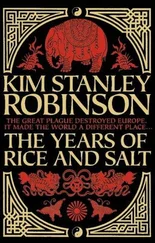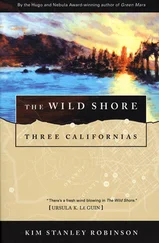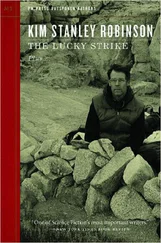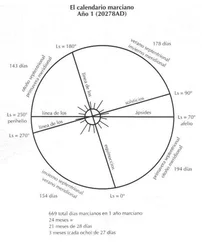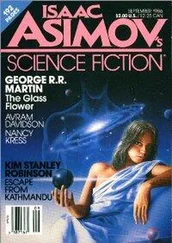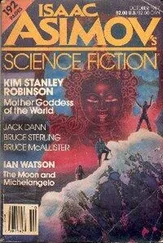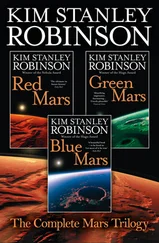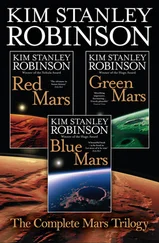“Which one is this?” Stephan inquires.
“This is the Altamira .”
Roger sails them around in a sweet curve that ends with them stalled into the wind and skidding to a halt. He retracts the cockpit dome. “I don’t intend to go up there, by the way, that’s an all-day trip no matter how you do it. My friends should be down here onshore to meet us.”
They step down onto the ice, which is mostly a dirty opaque white, cracked and a bit nobbled on the surface, so that it is slippery in some places, but mostly fairly steady underfoot; and Eileen sees that the treacherous spots stand out like windows inlaid in tile. Roger talks into his wristpad, then leads them into the fjord, which on one steep side displays a handsome granite staircase, frost lying like a fluffy carpet on the steps.
Up these stairs Roger climbs, putting his feet in earlier boot prints. Up on the headland over the fjord they have a good view over the ice to the township, which is really very big for a manufactured object, a kilometer on each side, and its deck only just lower than they are. Its square-tented middle glows green like a Renaissance walled garden, the enchanted space of a fairy tale.
There is a little stone shelter or shrine on the headland, and they follow the sidewalk over to it. The wind chills Eileen’s hands, toes, nose, and ears. A big white plate, whistling in the wind. Elysium bulks behind them, its two volcanoes just sticking over the high horizon to the west. She holds Roger’s hand as they approach. As always, her pleasure in Mars is mixed up with her pleasure in Roger; at the sight of this big cold panorama love sails through her like the wind. Now he is smiling, and she follows his gaze and sees two people through the shelter’s open walls. “Here they are.”
They round the front of the shrine and the pair notices them. “Hi all,” Roger says. “Eileen, this is Freya Ahmet and Jean-Claude Bayer. They’re going to be joining us. Freya, Jean-Claude, this is Eileen Monday.”
“We have heard of you,” Freya says to her with a friendly smile. She and Jean-Claude are both huge; they tower over the old ones.
“That’s Hans and Frances behind us, down the path there arguing. Get used to that.”
Hans and Frances arrive, then Arthur and Stephan. Introductions are made all around, and they investigate the empty shrine or shelter, and exclaim over the view. The eastern side of the Elysian Massif was a rain shadow before, and now it bulks just as black and empty as ever, looking much as it always has. The huge white plate of the sea, however, and the incongruous square of the Altamira ; these are new and strange. Eileen has never seen anything like it. Impressive, yes; vast; sublime; but her eye always returns to the little tented greenhouse on the township, tiny stamp of life in a lifeless universe. She wants her world back.
On the way back down the stone stairs she looks at the exposed granite of the fjord’s sidewall, and in one crack she sees black crumbly matter. She stops to inspect it.
“Look at this,” she says to Roger, scraping away at rime to see more of it. “Is it lichen? Moss? Is it alive? It looks like it might be alive.”
Roger sticks his face right down into it, eyes a centimeter away. “Moss, I think. Dead.”
Eileen looks away, feeling her stomach sink. “I’m so tired of finding dead plants, dead animals. The last dozen times out I’ve not seen a single living thing. I mean winterkill is winterkill, but this is ridiculous. The whole world is dying!”
Roger waggles a hand uncertainly, straightens up. He can’t really deny it. “I suppose there was never enough sunlight to begin with,” he says, glancing up at their bronze button of light, slanting over Elysium. “People wanted it and so they did it anyway. But reality isn’t interested in what people want.”
Eileen sighs. “No.” She pokes again at the black matter. “Are you sure this isn’t a lichen? It’s black, but it looks like it’s still alive somehow.”
He inspects some of it between his gloved fingers. Small black fronds, like a kind of tiny seaweed, frayed and falling apart.
“Fringe lichen?” Eileen ventures. “Frond lichen?”
“Moss, I think. Dead moss.” He clears away more ice and snow. Black rock, rust rock. Black splotches. It’s the same everywhere. “No doubt there are lichens alive, though. And Freya and Jean-Claude say the subnivean environment is quite lively still. Very robust. Protected from the elements.”
Life under a permanent blanket of snow. “Uh-huh.”
“Hey. Better than nothing, right?”
“Right. But this moss here was exposed.”
“Right. And therefore dead.”
They start down again. Roger hikes beside her, lost in thought. He smiles: “I’m having a déjà vu. This happened before, right? A long time ago we found some little living thing together, only it was dead. It happened before!”
She shakes her head. “You tell me. You’re the memory man.”
“But I can’t quite get it. It’s more like déjà vu. Well, but maybe . . . maybe on that first trip, when we first met?” He gestures eastward—over the Amazonian Sea, she guesses, to the canyon country east of Olympus. “Some little snails or something.”
“But could that be?” Eileen asks. “I thought we met when I was still in college. The terraforming had barely started then, right?”
“True.” He frowns. “Well, there was lichen from the start, it was the first thing they propagated.”
“But snails?”
He shrugs. “That’s what I seem to remember. You don’t?”
“No way. Just whatever you’ve told me since, you know.”
“Oh well.” He shrugs again, smile gone. “Maybe it was just a déjà vu.”
Back in the iceboat’s cockpit and cabin, they could be crowded around the kitchen table of a little apartment anywhere. The two newcomers, heads brushing the ceiling even though they are sitting on stools, cook for them. “No, please, that is why we are here,” Jean-Claude says with a big grin. “I very much like to be cooking the big meals.” Actually they’re coming along to meet with some friends on the other side of the Amazonian Sea, all people Roger has worked with often in the last few years, to initiate some research on the western slope of Olympus—glaciology and ecology, respectively.
After these explanations they listen with the rest as Hans and Frances argue about the crash for a while. Frances thinks it was caused by the rapid brightening of the planet’s albedo when the north sea was pumped out and froze; this the first knock in a whole series of positively reinforcing events leading in a negative direction, an autocatalytic drop into the death spiral of the full crash. Hans thinks it was the fact that the underground permafrost was never really thawed deeper than a few centimeters, so that the resulting extremely thin skin of the life zone looked much more well established than it really was, and was actually very vulnerable to collapse if attacked by mutant bacteria, as Hans believes it was, the mutations spurred by the heavy incoming UV—
“You don’t know that,” Frances says. “You radiate those same organisms in the lab, or even expose them in space labs, and you don’t get the mutations or the collapses we’re seeing on the ground.”
“Interaction with ground chemicals,” Hans says. “Sometimes I think everything is simply getting salted to death.”
Frances shakes her head. “These are different problems, and there’s no sign of synergistic effects when they’re combined. You’re just listing possibilities, Hans, admit it. You’re throwing them out there, but no one knows. The etiology is not understood.”
That is true; Eileen has been working in Burroughs on the problem for ten years, and she knows Frances is right. The truth is that in planetary ecology, as in most other fields, ultimate causes are very hard to discern. Hans now waggles a hand, which is as close as he will come to conceding a point to Frances. “Well, when you have a list of possibilities as long as this one, you don’t have to have synergy among them. Just a simple addition of factors might do it. Everything having its particular effect.”
Читать дальше
Конец ознакомительного отрывка
Купить книгу


